Canadian Safe Boating Course
Chapter 1: Safe Boating Regulations, Acts, and
Codes
The operation of a pleasure craft is subject
to several sets of legislation which govern
everything from life jackets to required
markings and rules to avoid collisions. The
specific acts and regulations which pleasure
craft operators need to concern themselves are:
Canada Shipping Act and the Criminal Code of
Canada
- Watch for signals that indicate distress
and need of assistance
- Render assistance to every person who is
found at sea and in danger of being lost ..
without posing serious danger to their own
craft and the persons on board
- Stop and offer assistance when the
operator is involved in an accident
- Must not operate boat in a dangerous
manner
- Must keep watch on person towed
- Cannot tow person after dark
- Cannot drive a craft that is un
seaworthy
- Cannot drive craft under the influence
(alcohol, drugs etc..)
- Cannot send false messages
- Cannot interfere with marine signals.
It is illegal to: Alter, remove, conceal
or anchor to nautical aids
Small Vessel Regulations
- The operator of a pleasure craft must
carry specific safety equipment on board
their vessel. The type and amount of
equipment is determined by the size of the
craft.
- The operator of a pleasure craft must
ensure that all required equipment for their
vessel is maintained in proper working
order.
- The operator must ensure that the vessel
is properly licensed. (All vessels with
motors 10 HP and over must be licensed)
- The license numbers or letters must
comply with the requirements specified in
the Small Vessel Regulations, Licensing of
Vessels and Marking of Vessels.
- Regulations pertaining to Engine Power
and Load Capacity
- Regulations regarding PFD’s and Life
jackets
- Regulations regarding pyrotechnic
distress signals. Pyrotechnic distress
signals must be approved by “Department of
Transport Canada”. These distress signals
are no longer considered to be approved, if
more than 4 years has elapsed from the date
of manufacture. This date is clearly marked
on the distress signal.
- Regulations regarding required contents
for emergency kits.
The Contraventions Act
The Contraventions Act, which received Royal
Assent in October 1992, was not proclaimed in
force until August 1, 1996, pending development
of a cost-effective ticketing scheme for
handling minor federal offences such as speeding
on federal roads and boating without the proper
safety equipment on board. Using existing
provincial and territorial schemes, rather than
creating a federal scheme for ticketing federal
offences, will help to reduce costs associated
with the administration of justice and eliminate
overlap and duplication. This change is intended
to reduce the load on the court system. As with
any ticket, the offender will have the option of
pleading guilty and making payment to the
competent authorities or to plead not guilty and
going to court
Boating Restriction Regulations
Boating Restriction Regulations are specific
to certain waters and waterways in Canada. They
specify:
- Prohibited vessel types on a given
waterway
- Standardized speed limits on a given
waterway
- Maximum engine horsepower on a given
waterway
- Power vessel restriction (Lac Phillipe
.. no motors allowed etc..)
- Water skiing restrictions .. and many
others.
Boating Restriction Regulations can also be
passed and enforced by local municipal
governments, therefore, it's important to pay
close attention to all signs encountered while
boating.
How do you read a restriction sign?
There are five types of shapes for the
restriction signs. The frame colour is
international orange. Signs with a section with
a green border indicate that a special condition
applies to the restriction (for example, the
day/time an activity is allowed). The symbol on
the sign indicates the type of restriction which
applies. If the sign is arrow-shaped, the
restriction applies in the direction pointed by
the arrow.
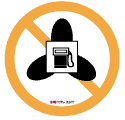
No internal combustion or steam engine
is permitted
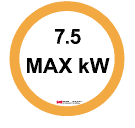
Power limit
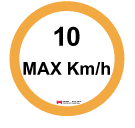
Standardized speed limit
(normally 5,10,25,40,55)

No boats
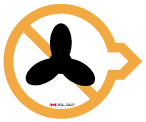
No power driven vessels in the direction
indicated by the arrow
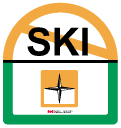
No skiing north of the sign
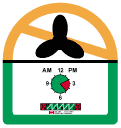
No power vessels between the hours and
days in red
Charts and Nautical Publications Regulations
The operator of a pleasure craft not
propelled by oars shall have on board, in
respect of each area in which the craft is to be
navigated, as described in the Charts and
Nautical Publications Regulations, the most
recent editions of:
- The largest scale charts
- The required publications
- The required documents
- UNLESS ... the vessel is under 100
tonnes or the operator is familiar with the
waterway
Collision Regulations
- These are International regulations to
prevent collisions at sea and the Canadian
modifications. They apply to the high seas
and in all waters connected to the high seas
that are considered to be navigable. They
define common terms (i.e. Port, starboard,
stern, bow, draft etc..)
- They state that .. “the operator of
pleasure power driven craft shall take early
and substantial action to keep well clear of
a vessel engaged in fishing, or a sailing
vessel.
- They state that .. “the operator of a
pleasure sailing craft shall take early and
substantial action to keep well clear of a
vessel engaged in fishing.
- They set common rules for power driven
vessels, sailing vessels, fishing vessels,
etc.. The rules are designed so that all
operators know what is required of them and
to give them knowledge of what the
approaching vessel is going to do.
- These regulations require that you keep
a proper lookout by sight and hearing to
prevent accidents
- They require that you use all available
means to avoid accidents .. adjust speed,
keep well clear, exhibit vigilance while
operating craft etc..
- They state that the following factors
must be taken into account when determining
a safe speed:
- the state of visibility
- the traffic density including
concentrations of fishing or other
vessels
- state of the wind
- sea and current
- proximity to navigational hazards
- They specify that boats less than 20
metres shall not impede the passage of a
large craft in a narrow channel ..
regardless of who has the defined right of
way
- Collision regulations define who has the
right of way when motor boat meets motor
boat .. when motor boat meets sailboat ..
when sailboat meets sailboat .. when sail or
motor boat meets fishing boat etc..
- Collision Regulations require the boat
with the right of way to maintain their
course and speed
- They require the operator of the craft
to adjust their speed according to
visibility, traffic density, wind and state
of the water and proximity to navigational
hazards.
- They make boaters responsible for your
own wake or wash. If your wake causes a
canoe or rowboat to capsize .. you are
responsible .. be aware of where you are ..
watch for swimmers!
- Collision Regulations require that you
stay clear of a boat showing Code of Signals
“A” – which indicates that they have a
“diver down”. You are legally required to
slow down and steer clear.
- They explain required sound and light
signals. (I.e. sound one long sound
immediately followed by one short when
visibility is reduced)
- They define distress signals so all
boaters recognize them
- They cover other required equipment
which is pertinent to specific sizes of
vessels (i.e. passive radar reflectors
etc.)
As a pleasure craft operator, you must be
aware of the differing factors that can affect
you and your passengers. Some of these factors
are:
| Action |
Effect |
| Motion of the pleasure craft |
dizziness and nausea |
| Sunlight |
eyesight, dehydration,
sunburn or sunstroke |
| Waves |
balance, dizziness and
nausea |
| Wind |
dehydration, hypothermia,
balance |
| Sound |
engine noise and natural
water noise reduce hearing
acuity |
| Alcohol |
dizziness, nausea, poor
judgement |
As a responsible pleasure craft operator, it
is important to remember that we share the
waterways with many different and varied
activities. You must be aware of:
- swimmers and properties
- adjust the speed of your craft so that
the draw-off and wave disturbance generated
by the passage of your craft does not cause
injury to persons, erosion of the shoreline
or damage to others properties
- know and obey Collision Regulations
- use courtesy and common sense so as not
to create a hazard, a threat, a stress or an
irritant to themselves, to others, to the
environment or to wildlife.
One of the most important thing that a boater
should do before heading out in their pleasure
craft is to check the weather forecast. This
can be done quite accurately and effectively by
using the following sources:
- personal observations .. (does it look
like rain?)
- newspapers
- radio
- television weather channel
- radiotelephones
- Environment Canada
Weather forecasts in Canada are described
using the following terms which describe
anticipated wind conditions:
| Term |
Description |
| Light winds |
wind speeds less than 12
knots |
| Moderate winds |
wind speeds in the range of
12 to 19 knots |
| Strong Winds |
sustained wind speeds in the
range of 20 to 33 knot |
| Small Craft Warning |
sustained wind speeds in the
range of 20 to 33 knots |
| Gale Warning |
sustained wind speeds in the
range of 34 to 47 knots |
| Storm Warning |
sustained wind speeds in the
range of 48 to 63 knots |
| Hurricane Warning |
sustained wind speeds in the
range of 64 knots or more |
It is extremely important for all operators
to check the weather forecast prior to departure
to avoid putting the craft and persons on board
at risk.
There are also numerous potential local
hazards that should be considered before
departure as well. Some of these could include:
- low-head dams
- rapids
- sudden winds
- tides
- currents
- white water
- overhead cables
- underwater cables
- bridges
- rapid build up of high wave conditions
Ensure that you are equipped with the most
recent Nautical Chart for the areas in which you
will be operating your craft.
Trip Plans
Another useful safety measure is filing a
trip plan. Before heading out, the operator of
a pleasure craft should complete a thorough trip
plan and file it with a responsible person who
is familiar with the instructions to follow in
case of emergency. During the trip, the plan
should be updated to avoid an unnecessary call
for help should you decide to deviate from your
original plan. Filing a trip plan will assist
rescuers when it is necessary to initiate a call
for search and rescue in case of emergency.
The trip plan should contain the following
information:
- name and registration number of craft
- type of craft .. sailing or power driven
- name, address and phone # of owner
- number of persons on board
- size, type and colour of craft
- engine type (inboard, outboard)
- distinguishing features of craft
- type of radiotelephone and channel
monitored
- safety equipment on board
- emergency instructions
- trip description: departure time,
return time, and proposed route
Pre-departure Checklist
Another helpful tip is to make and fill-out a
checklist of all required equipment and supplies
prior to leaving the dock. This will help to
avoid situations which could lead to unnecessary
emergencies, (such as running out of fuel,
dehydration, hypothermia etc).
Emergency Kit
An emergency kit is an item that is often
overlooked when equipping a pleasure craft.
These items could be kept in a plastic bag or a
sealable watertight plastic container of
sufficient size.
This kit should include:
- a flashlight
- a whistle
- a knife
- a first aid kit
- emergency rations
- drinking water
- dry clothing.